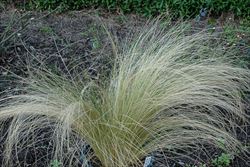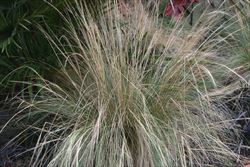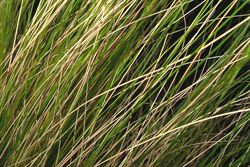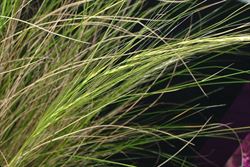Click on images to enlarge

habit (Photo: Rob and Fiona Richardson)

habit in flower (Photo: Rob and Fiona Richardson)

leaves (Photo: Sheldon Navie)

close-up of the very narrow leaves (Photo: Sheldon Navie)

young seed-head (Photo: Sheldon Navie)

close-up of flower spikelets (Photo: Sheldon Navie)
Scientific Name
Nassella tenuissima (Trin.) Barkworth
Synonyms
Stipa cirrosa E. Fourn. ex Hemsl.Stipa geniculata Phil.Stipa mendocina Phil.Stipa oreophila Speg.Stipa subulata E. Fourn. ex Hemsl.Stipa tenuissima Trin.
Family
Gramineae (South Australia)Poaceae (Queensland, New South Wales, the ACT, Victoria, Tasmania, Western Australia and the Northern Territory)
Common Names
angel hair grass, angel's hair, fine-stem needle grass, finestem needlegrass, finestem tussockgrass, Mexican feather grass, Mexican feathergrass, pony tails, Texas tussock grass, tussock grass, tussockgrass, white tussock
Origin
This species is thought to be native to south-eastern USA (i.e. Texas and New Mexico), Mexico and southern South America (i.e. Argentina and Chile).
Cultivation
This species is occasionally cultivated as an ornamental grass.
Naturalised Distribution
Mexican feathergrass (Nassella tenuissima ) is sparingly naturalised in southern Victoria.
Also naturalised overseas in New Zealand and South Africa, and naturalised beyond its native range in California in south-western USA.
Habitat
This species is a potential weed of temperate and semi-arid regions that will most likely invade pastures, grasslands, grassy open woodlands, disturbed sites, roadsides and waste areas.
Habit
A tufted long-lived (i.e. perennial) grass with upright (i.e. erect) or slightly creeping (i.e. decumbent) stems usually growing 25-70 cm tall, but occasionally reaching up to 1 m in height.
Distinguishing Features
- a tufted long-lived grass with upright growing 25-70 cm tall.
- its linear leaves are very slender (less than 1 mm wide).
- its seed-head is an open but slender branched panicle (10-30 cm long) with many flower spikelets that are borne singly.
- these flower spikelets (5-11 mm long) are elongated in shape and topped with a very long awn (50-90 mm long).
- the mature seed has a ring of tiny hairs (0.2-0.3 mm long) where the bent and twisted awn attaches to the top of the seed.
Stems and Leaves
The flowering stems (i.e. culms) are mostly hairless (i.e. glabrous) and most of the leaves are tufted around the base of the plant.
The leaves are very fine (i.e. filiform) with sheaths and blades that are also mostly hairless (i.e. glabrous). The leaf blades (7-40 cm long and about 0.5 mm wide) are entire with long pointed tips (i.e. acuminate apices). Where the leaf sheath meets the leaf blade there is a small membranous structure (i.e. eciliate ligule) that is 1.5-4 mm long.
Flowers and Fruit
The seed-head (10-30 cm long) is an open, but slender, panicle with numerous flower spikelets that are borne singly at the tips of the branches. Each flower spikelet contains two tiny flowers (i.e. florets), one of which is fertile and one of which is sterile, and two bracts (i.e. glumes). These flower spikelets (5-11 mm long) are elongated (i.e. lanceolate) in shape and are topped with a very long awn. Flowering occurs mostly during summer.
When mature the 'seed' separates from the bracts (i.e. glumes), which remain on the seed-head branches. The mature 'seed' has a sharpened, hairy tip (i.e. pilose callus) at one end and a large bent awn (50-90 mm long) at the other end. Where the awn attaches to the seed there is a small collar-like ring of tiny hairs (i.e. coma) that are only 0.2-0.3 mm long. Hidden within the hard-coated 'seed' is the small (1.5-2 mm long) dark brown-coloured, and elongated (i.e. linear) grain.
Reproduction and Dispersal
This species reproduces via seed. These seeds are commonly spread by the wind and also become attached to animals, clothing and vehicles. They may also be dispersed in contaminated agricultural produce (e.g. fodder) and soil.
Environmental Impact
Mexican feathergrass (Nassella tenuissima) is regarded as an environmental weed in Victoria and as a potential environmental weed in other parts of southern Australia. It was recently listed as a priority environmental weed in at least one Natural Resource Management region.
Legislation
This species is declared under legislation in the following states and territories:
- New South Wales: Class 1- a state prohibited weed. The presence of the weed on land must be notified to the local control authority and the weed must be fully and continuously suppressed and destroyed (throughout the entire state).
- Queensland: Class 1 - introduction into the state is prohibited, and landowners must take reasonable steps to keep land free of this species (throughout the entire state). It is also illegal to sell a declared plant or its seed in this state.
- South Australia: 1@ - this species is declared under Class 1c(i), a classification for prohibited terrestrial plants. Its presence must be notified and the plant must be destroyed (throughout the entire state).
- Victoria: S - prohibited and is to be eradicated from the state if possible.
- Western Australia: P1 - trade, sale or movement into the state prevented, and P2 - to be eradicated (throughout the entire state).
Management
For information on the management of this species see the following resources:
- the Victorian Department of Primary Industries Landcare Note on this species, which is available online at http://www.dpi.vic.gov.au.
Similar Species
Mexican feathergrass (Nassella tenuissima) is very similar to serrated tussock (Nassella trichotoma) and these two species can usually only be distinguished when in flower. They have the following differences:
- Mexican feathergrass (Nassella tenuissima ) seeds have a very large awn (50-90 mm long).
- serrated tussock (Nassella trichotoma) seeds have a relatively small awn (15-35 mm long).
Mexican feathergrass (Nassella tenuissima) is also relatively similar to Chilean needle grass (Nassella neesiana), lobed needlegrass (Nassella charruana), cane needlegrass (Nassella hyalina), Texas needlegrass (Nassella leucotricha) and short-spined needlegrass (Nassella megapotamia). However, these grasses generally have wider leaves (usually 1-5 mm wide) and have a membranous crown-like structure (i.e. corona) where the awn meets the top of the seed. Also, some of these species (i.e.Nassella neesiana, Nassella hyalina and Nassella leucotricha) produce of stem seeds (i.e. cleistogenes).
In addition, several native tussock-forming grasses can look similar (e.g. Poa spp. and Austrostipa spp.). However, these species either lack ligules on their leaves or have ligules that are fringed with hairs.
Note: This page only covers those grasses that are commonly confused with this species. For a more in-depth key to all of the grasses present in Australia, see the AusGrass: Grasses of Australia CD-ROM or Flora of Australia, Volumes 43 and 44.

